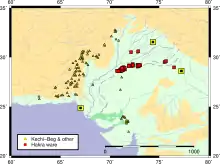Hakra Ware culture
Hakra Ware culture is a material culture which is contemporaneous with the early Harappan Ravi phase culture (3300–2800 BCE) of the Indus Valley.[1][2] Hakra Ware culture is characterized by handmade vessels with mud and grit applied to the surface. The Hakra Wares culture also made structures in the form of subterranean dwelling pits, cut into the natural soil. The walls and floor of these pits were plastered with the yellowish alluvium of the Hakra valley.[3] The first example was found near Jalilpur on the Ravi River about 80 miles (130 km) southwest of Harrappa in 1972.[4] According to Rao, Hakra Ware has been found at Bhirrana, and is pre-Harappan, dating to the 8th–7th millennium BCE.[5][6][7]

Map with Hakra Ware sites in red
References
- Coningham & Young 2015, p. 158.
- Ahmed 2014, p. 107.
- Singh 2008, p. =109, 145, 153.
- Mughal, Rafique (Spring 2001). "Resurrecting Sir Aurel Stein from the Cholistan Desert" (PDF). Boston University Center for Archaeological Studies. 15.2.
- Dikshit 2013, p. 129-133.
- Mani 2008, p. 237-238.
- Sarkar 2006, p. 2-3.
Sources
- Coningham; Young (2015), The Archaeology of South Asia: From the Indus to Asoka, c.6500 BCE–200 CE, Cambridge University Press
- Dikshit, K.N. (2013), "Origin of Early Harappan Cultures in the Sarasvati Valley: Recent Archaeological Evidence and Radiometric Dates" (PDF), Journal of IndIan Ocean Archaeology No. 9, 2013, archived from the original (PDF) on 2017-01-18
- Mani, B.R. (2008), "Kashmir Neolithic and Early Harappan : A Linkage" (PDF), Pragdhara 18, 229–247 (2008), archived from the original (PDF) on 2017-01-18, retrieved 2017-01-17
- Sarkar, Anindya (2016), "Oxygen isotope in archaeological bioapatites from India: Implications to climate change and decline of Bronze Age Harappan civilization", Scientific Reports, 6: 26555, doi:10.1038/srep26555, PMC 4879637, PMID 27222033
- Singh, Upinder (2008), A History of Ancient and Early Medieval India : from the Stone Age to the 12th century, New Delhi: Pearson Education, pp. 109, 145, 153, ISBN 9788131711200
This article is issued from Wikipedia. The text is licensed under Creative Commons - Attribution - Sharealike. Additional terms may apply for the media files.